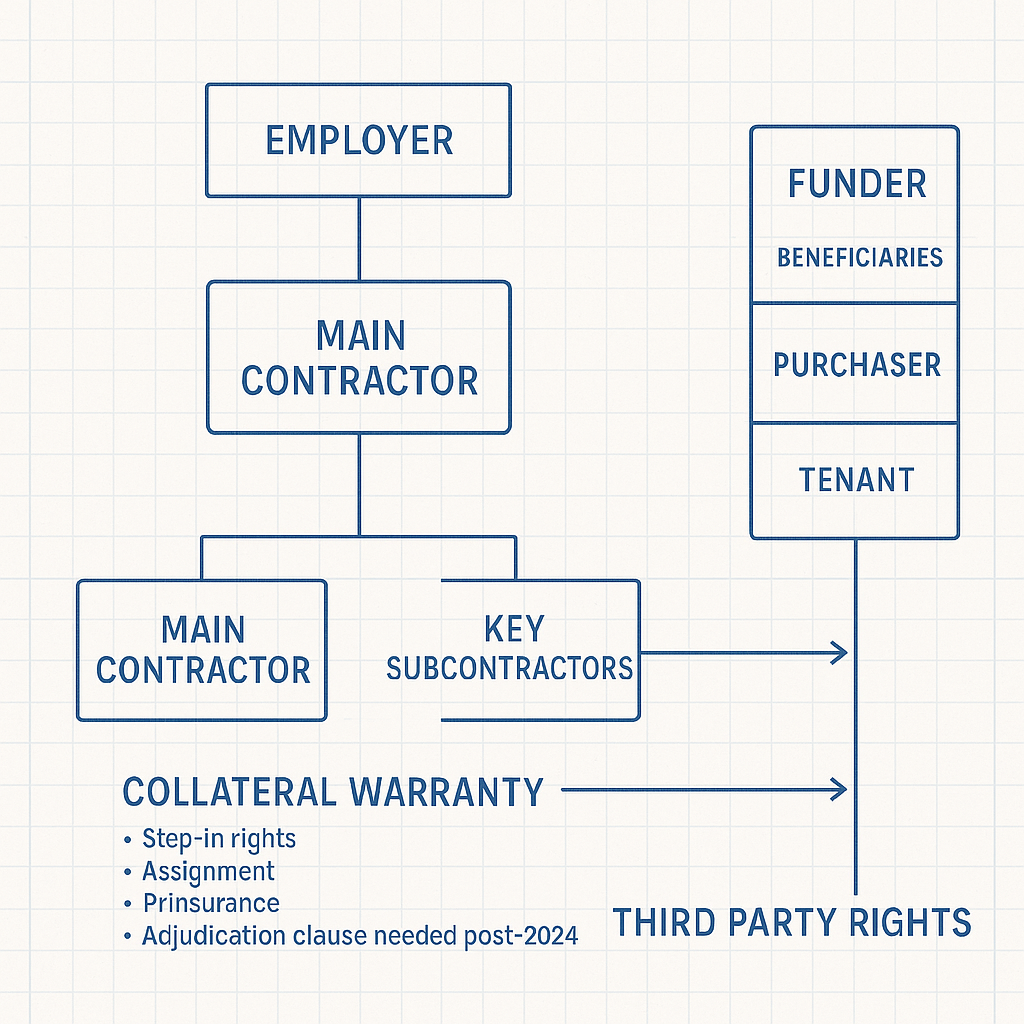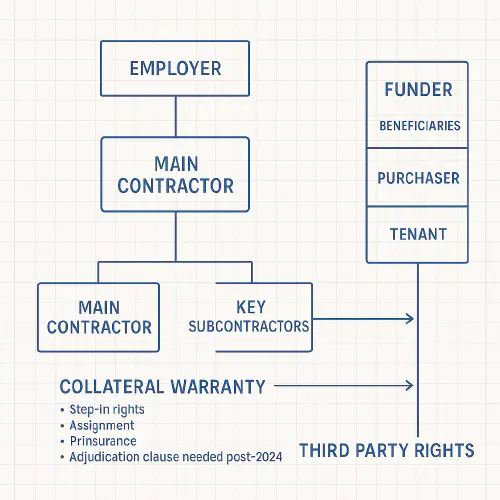
Collateral warranties vs Third‑Party Rights (JCT and NEC): who needs what, key clauses and the 2024 adjudication change
Collateral warranties vs Third‑Party Rights (JCT and NEC): who needs what, key clauses and the 2024 adjudication change
Category: Business & Operations • Niche: Contracts, JCT, NEC, funders/tenants/purchasers
Contents
- Quick answer
- Where these rights live in JCT and NEC
- Who needs what: fast mapping
- Key clauses to get right
- After Abbey Healthcare v Simply Construct (2024): adjudication
- Practical drafting checklists
- FAQs

Blueprint-style flow showing Employer → Contractor/Subcontractors with Beneficiaries via Collateral Warranty or Third‑Party Rights
Quick answer
- A collateral warranty is a separate contract (from contractor/consultant/subbie) to a third party (funder, purchaser or tenant) giving that party a direct claim for defects.
- Third‑Party Rights (TPR) put similar rights inside the main contract using the Contracts (Rights of Third Parties) Act 1999. You name the beneficiaries and the clauses they can enforce.
- JCT 2024 has up‑to‑date model warranty forms for each beneficiary. NEC4 uses Option X8 (Undertakings) for warranties and Y(UK)3 for TPR.
- Supreme Court 2024: most collateral warranties are not “construction contracts,” so there’s no automatic statutory right to adjudicate. If you want adjudication under a warranty or TPR, add an express clause.
Where these rights live in JCT and NEC
JCT (2024 suite)
Rights Particulars: specify if you’ll use collateral warranties or TPR (or both), who benefits, and who must give them. Helpful explainer: Mills & Reeve.
Model forms you’ll see in practice:
- Contractor → Funder: CWa/F 2024 (JCT)
- Contractor → Purchaser or Tenant: CWa/P&T 2024 (Construction Books)
- Subcontractor → Funder: SCWa/F 2024 (JCT)
- Subcontractor → Purchaser or Tenant: SCWa/P&T 2024 (JCT)
- Subcontractor → Employer: SCWa/E 2024 (Construction Books)
Background on JCT updates: Construction Enquirer.
NEC4
- Option X8 Undertakings: put collateral warranty obligations in the Scope; name who must give them, to whom, and attach the form you’ll use. Quick overview: Hardwick Legal.
- Option Y(UK)3: turns on Third‑Party Rights under the 1999 Act; name beneficiaries and the clauses they can enforce. If you don’t want TPRs, state “None.” Explainer: Sharpe Pritchard.
Who needs what: fast mapping
- Funders: want step‑in rights, assignment on syndication, PI undertakings, and a direct claim. Use JCT CWa/F or an NEC X8 undertaking; TPRs work if drafted carefully.
- Purchasers/forward‑fund buyers: direct claim for latent defects, flexible assignment on resale. JCT CWa/P&T or SCWa/P&T.
- Tenants: similar to purchasers; usually limited to their demise. JCT CWa/P&T or SCWa/P&T.
- Employers: warranties/TPR from key subcontractors and designers to keep a direct route if the main contractor is insolvent. JCT SCWa/E or parallel TPR.
Useful background: Cripps and Charles Russell Speechlys.
Key clauses to get right
- Standard of care: reasonable skill and care; avoid fitness‑for‑purpose unless priced and insured.
- No greater liability: cap liability to that in the underlying contract; align time bars and defences.
- PI insurance: state level and maintenance period; undertakings to notify lapses.
- Deleterious materials: include the usual list and relevant standards.
- Assignment: typical market position is two assignments without consent; funders often need wider rights.
- Net contribution: many beneficiaries resist; check if included by default in your TPR schedule and negotiate accordingly. Helpful context: Ashfords.
- Step‑in (funders): add notice, cure periods, and a binding assumption of employer obligations on step‑in (including payment).
- Adjudication: post‑2024, add an express adjudication clause if you want adjudication under the warranty/TPR.
After Abbey Healthcare v Simply Construct (2024): adjudication
- The Supreme Court decided most collateral warranties are not “construction contracts,” so the statutory right to adjudicate does not automatically apply. If you want adjudication, add it expressly.
- Same point for TPR beneficiaries: they’re not parties to a construction contract, so build an adjudication right into the TPR schedule if needed.
Useful explainers: Mondaq overview and earlier context on third‑party adjudication: CMS LawNow.
Practical drafting checklists
JCT Rights Particulars (what to fill in)
- Tick method(s): Collateral Warranties, Third‑Party Rights, or both.
- Name beneficiaries: funder, purchaser, tenant, employer; add “successors and assigns” where needed.
- Who must give rights: main contractor; named/novated designers; key subcontractors (M&E, façade, frame, roofing, groundwork).
- Attach forms: JCT CWa/F, CWa/P&T, SCWa/F, SCWa/P&T, SCWa/E in the Contract Particulars or a Schedule.
- Assignment: set “two without consent” unless your funder insists on more; carve out security assignments.
- Adjudication: add an express clause in each warranty and mirror it in TPR schedules if you want that forum.
NEC4 (where to put it)
- Contract Data: list beneficiaries; reference Option X8 and Y(UK)3 if used.
- Scope: include the actual undertaking wording and who signs (contractor/subcontractors/consultants) and by when.
- Step‑in: draft a clean step‑in mechanism for the funder with notices and obligation‑assumption wording.
- Alignment: mirror limits, caps, time bars, PI and deleterious materials undertakings with the main contract.
- Adjudication: add an express right within the X8 undertaking and in the Y(UK)3 schedule if you want beneficiaries to adjudicate.
FAQs
Is a collateral warranty better than Third‑Party Rights?
It depends. Warranties feel more tangible to funders and buyers, and they’re easier to assign. TPRs are cheaper and quicker because you don’t chase signatures. On complex schemes, many employers use both.
Can I get step‑in via Third‑Party Rights?
Yes, but draft it carefully. The beneficiary’s step‑in notice should include an undertaking to assume employer obligations (including payment) from the step‑in date.
Do I need a warranty from every subcontractor?
Focus on risk: design‑heavy, safety‑critical or envelope trades typically give warranties or TPRs. Follow your funder’s security package checklist.
Can a beneficiary adjudicate under a warranty after 2024?
Not automatically. Add an express adjudication clause. Without it, your forum is likely litigation or negotiated settlement.
What about PI insurance being claims‑made?
State that the warrantor keeps PI at an agreed minimum for a defined period and notifies material reductions or exclusions. Consider project‑specific PI for major schemes.
Want to slash training times and increase revenue per Engineer? Join our Waitlist: https://trainar.ai/waitlist